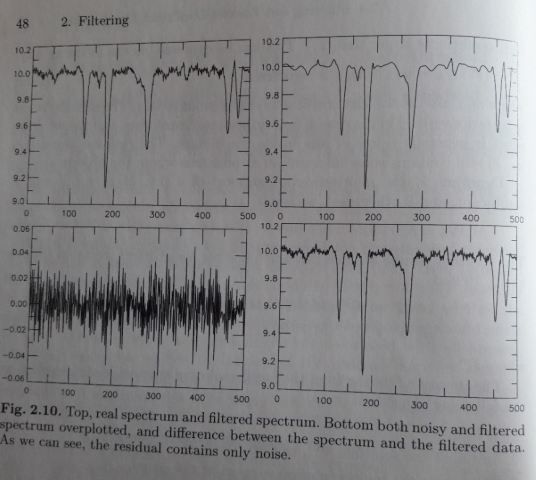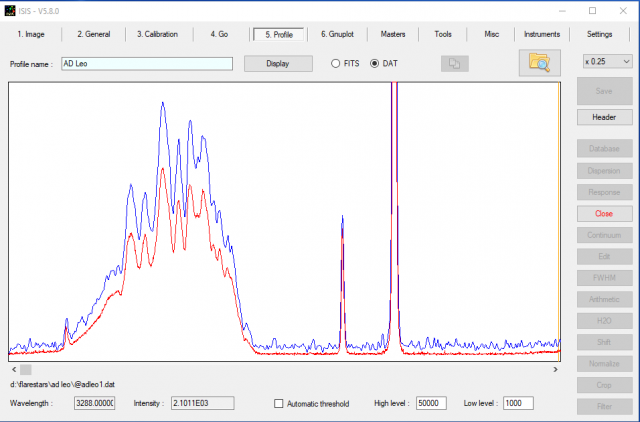› Forums › Spectroscopy › Catch a flaring star
- This topic has 8 replies, 3 voices, and was last updated 6 years, 8 months ago by
 Dr Andrew Smith.
Dr Andrew Smith.
-
AuthorPosts
-
8 April 2019 at 1:08 pm #574303
 Dr Andrew SmithParticipant
Dr Andrew SmithParticipantI have come to the conclusion that the weather has beaten my attempts to exploit my echelle spectrographs. Just too many cloudy nights with infrequent and all too short clear spells.
In view of this I am planning to observe flare stars in the hope of capturing low resolution spectra of the flares.
Robin did this serendipitous in 2012 see here http://www.threehillsobservatory.co.uk/astro/spectra_42a.htm.
The plan is to use a Star Analyser 200 and automation to acquire flare stars and observe them for as long as possible at high cadence.
The automation will monitor the star and trigger on a flare to store the spectra just before, during the flare and into steady state mimicking how UFO does for meteor capture.
Further, the idea is to exploit the low read noise, fast download and small pixels of a CMOS camera together with modern imaging processing methods to process the spectra.
I was impressed by this

from “Astronomical Image and Data Analysis” by Jean-Luc Starck and Fionn Murtagh. I think this is an area amateur spectroscopist have not yet exploited.
The Python program needed for this will occupy the cloudy nights!
I would be interested in any comments and advice.
Regards Andrew
Attachments:
8 April 2019 at 2:34 pm #580955 Robin LeadbeaterParticipant
Robin LeadbeaterParticipantAn interesting idea Andrew.
For anyone interested, there is a more in depth analysis of that event here (2:28-12:30)
https://britastro.org/video/13862/14769
I was indeed lucky and spent a few more nights without catching anything. An auto system should determine how common they are. What do you plan to trigger on?
Increase in total (or wavelength specific eg blue) flux relative to other field stars ? (Might still be triggered by cloud movement at high cadence)
Increased temperature – flux(blue)/flux(red)? (Should be relatively insensitive to clouds which are ~grey and slow changes due to extinction)
Change in H alpha flux ? (Does H alpha generally change during these events? In this case the excess flux did appear to show some additional H alpha/beta emission). Andy Wilson’s speciality I think
Robin
8 April 2019 at 2:37 pm #580956 Jeremy ShearsParticipant
Jeremy ShearsParticipantThat sounds an interesting project, Andrew. I’ll be very interested to see how you get on.
8 April 2019 at 2:47 pm #580957 Dr Andrew SmithParticipant
Dr Andrew SmithParticipantHi Robin first idea is to use the zero order flux increase but initially I will just save it all and process off line until I am sure it is robust. The drive on the obs PC is large an fairly empty.
Some late M dwarf stars flare quite often so I will start with them.
Reading up on the flares it seems the flux increase is higher in the U then B etc. going down to low in R.
I will use an IR cut filter to get as far as I can into the U band without contamination. Although IR cut filters seem to cut UV as well!
Regards Andrew
8 April 2019 at 3:12 pm #580958 Dr Andrew SmithParticipant
Dr Andrew SmithParticipantHi Robin if you still have the raw fit images of your event would you share the with me then I could try my detection strategy on them ? I would of cause credit you as an when
Regards Andrew
8 April 2019 at 6:06 pm #580959 Robin LeadbeaterParticipant
Robin LeadbeaterParticipantHi Andrew,
If you are working in the first order there is no overlap at the UV end so no need to use an IR cut to get the UV part of the spectrum. The response of the Star Analyser rolls off quite rapidly at the UV end though. Note that the zero order has a rather odd spectral content. (Effectively the inverse of the grating response, so predominantly contains the blue and red ends with the central wavelengths missing.) An IR cut filter before the grating might therefore be useful to enhance the sensitivity of the zero order to changes specifically in the blue without affecting the spectrum as the IR part of the 1st order spectrum would be invalid in any case without an order filter to cut the overlapping 2nd order blue end. I’ll see if I can dig out the raw spectra for you to play with
Cheers
Robin
8 April 2019 at 6:37 pm #580960 Dr Andrew SmithParticipant
Dr Andrew SmithParticipantOpps I got the contamination the wrong way round thanks for pointing this out. I realise the 0 order is not photomericaly clean but in your result it certainly showed an increase. I will try various strategies as as long as I get a signal it is ok as I will save past spectra over a period long enough even if the trigger is a bit late. I am planning to use my past experience of control charts to spot the signal.
Thanks again and for offering to seek out the raw data..
Andrew
8 April 2019 at 7:36 pm #580961 Robin LeadbeaterParticipant
Robin LeadbeaterParticipantAh SPC, Western Electric Rules etc. I remember that became the thing at work after my boss made a trip to Japan. I then pointed out the various places in the paper mill where I had effectively already implemented it (though not by name) !
2 May 2019 at 9:53 pm #581024 Dr Andrew SmithParticipant
Dr Andrew SmithParticipantHere is a spectra of AD Leo an M class Red Dwarf that is known to flare. The red is 20s *107 images unfiltered and blue a single 20s exposure with a Gaussian filter set at 4 in ISIS. Not normalised or dark subtracted hence the offset and hight differences.
True rookie errors. Spectra red to blue, interloper star and not well aligned spectra to CMOS rows! Still waiting for the rotator to ease some of these issues.
Regards Andrew

-
AuthorPosts
- You must be logged in to reply to this topic.
